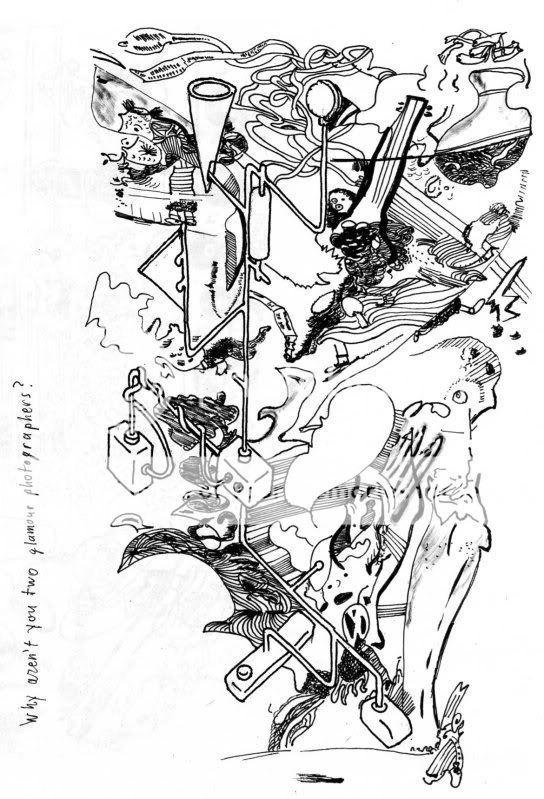This is something of a collaborative piece. I drew directly on some photocopied conceptual illustrations done by my good friend Bert Stabler for a video project
The Intangible Under Umbra. (Scroll down and you can see an excerpt; I did the voice for the talking brain plant thing.) The drawing itself is based on one of Bert's surreal Peanuts pastiches (
this one, in fact.)
Anyway, a lot of explanation for a fairly small drawing. Here 'tis.



Well, I don't know--even though it has some figurative elements the overall effect is closer to abstract. Certainly would have fit fine in the "Comic Abstraction" show at the MoMA. Also there are a number of pieces in the book that do have this kind of usage of figurative elements in them--Jeff Zenick's comes to mind. You'll see, one of the points I make in the intro is that the definition of "Abstract comics" should be perhaps closer to that of "abstract film" than "abstract painting"--and abstract film CAN incorporate representational elements.
ReplyDeleteAs for comic, I don't know--it's an image with a caption, right? It certainly fits R.C. Harvey's definition of a comic.
Abstract painting often has representational elements as well, actually....
ReplyDeleteyup, i diggit.
ReplyDelete"Abstract painting often has representational elements as well, actually...."
esp, see Sue Williams or Arturo Herrera for their abstractions using comics imagery.
"glamour photogrophers" reminds me of a surrealist exquisite corpse, but i do think it falls in the realm of an abstract comic, actually pushing the bounds a bit because it is frameless & as Andrei mentions about film, comics are closely tied to a gridded sequential progression, & tradcomics usually rely on that pattern -- however, there are exceptions, like Rube Goldberg, whose single panel inventions qualify as comics i think & akin to Goldberg, your comic has an inherent narrative that can be processed by the reader/viewer -- & the quite radical thing about abstract comics is how they are read/viewed as opposed to many tradcomics which rely on concrete portrait with single intent to convey the surfacial action that's going on (of course, there's many exceptions, but usually comic-creators go for direct exaggerated simplicity in hopes of reaching a broad audience & being easily understood) -- the thing about abstract comics is they are read completely different for each viewer because each individual viewer brings with them their own correlations of how to see the elements & their own particular way of processing those elements into a reading/viewing experience...
hmmm, i'll quit rambling & just say i dig the single panel layering technique you've presented here.
I really dig Troy's comment.
ReplyDeleteNoah, is that line something your son said, like in your other drawings?
reminds me of Öyvind Fahlström...
ReplyDelete